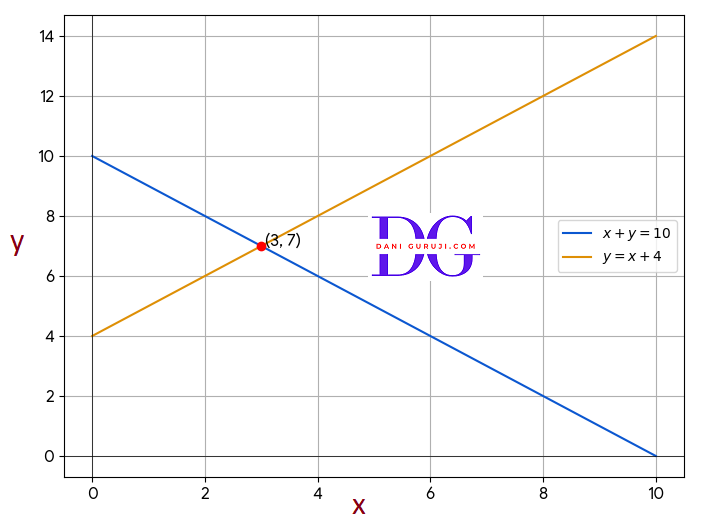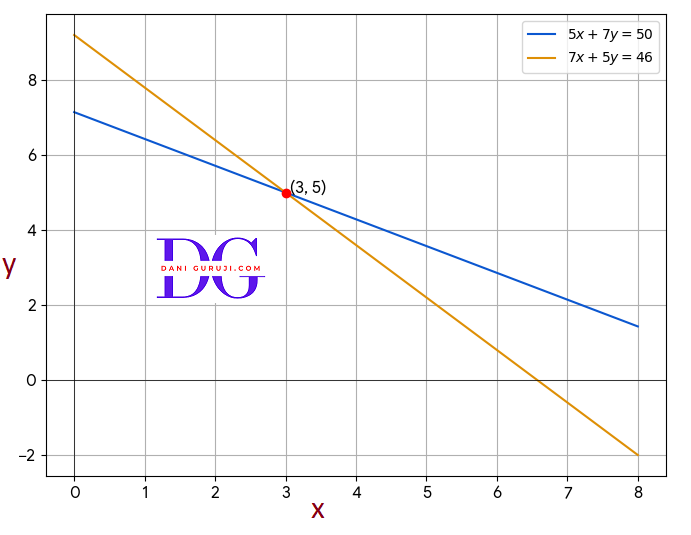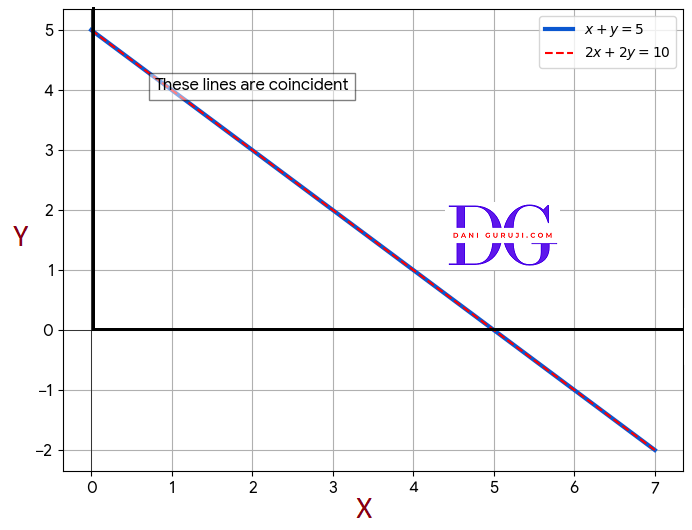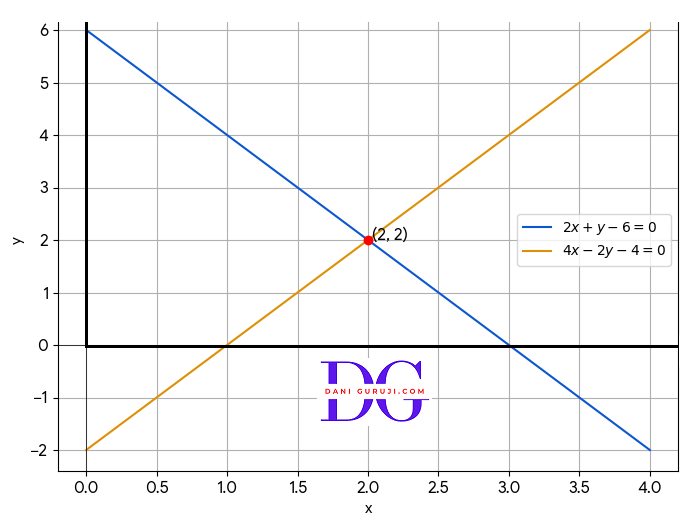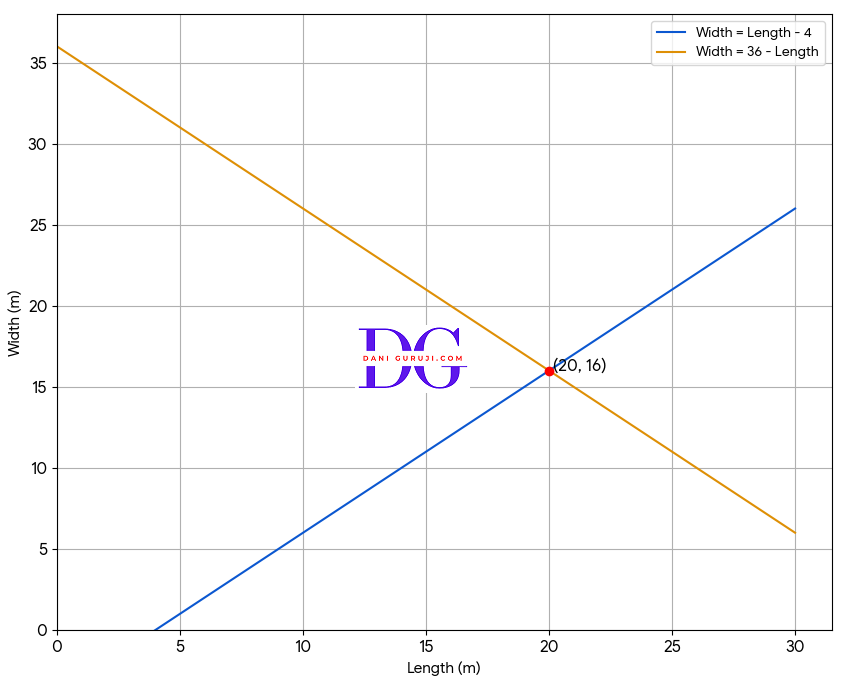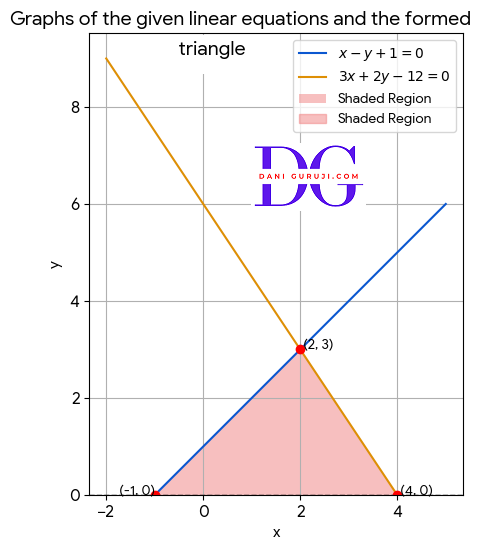Form the pair of linear equations in the following problems, and find their solutions graphically.
(i) 10 students of Class X took part in a Mathematics quiz. If the number of girls is 4 more than the number of boys, find the number of boys and girls who took part in the quiz.
Solution :
Let the number of boys as x and the number of girls as y.
According to the question given that total number of student is 10 so that
$${ x + y = 10} ..... (1)$$
According to the question given that Number of girls is 4 more than the number of boys,so that
$${ y = x + 4}..... (2)$$
Let us represent these equations graphically. For this, we need at least two or three solutions for each equation.
For equation (1) .
x + y = 10
y = 10- x
solutions in table shown below.
x
5
6
7
y = 10- x
5
4
3
For equation (2) .
y = x + 4
solutions in table shown below.
x
1
2
4
y = x + 4
5
6
8
The graphical representation is as follows.
From the figure, it can be observed that these lines intersect each other at point (3, 7).
Therefore, number of boys = 3 and number of girls = 7.
Form the pair of linear equations in the following problems, and find their solutions graphically.
(ii) 5 pencils and 7 pens together cost Rs 50, whereas 7 pencils and 5 pens together cost Rs 46. Find the cost of one pencil and that of one pen.
Solution :
Let the cost of one pencil as Rs. x and the cost of one pen as Rs. y .
According to the question
The cost of 5 pencils and 7 pens is Rs. 50
$${5x + 7y = 50 } ..... (1)$$
According to the question given also, the cost of 7 pencils and 5 pens is Rs. 46
$${ 7x + 5y = 46}..... (2)$$
Let us represent these equations graphically. For this, we need at least two or three solutions for each equation.
For equation (1)
5x + 7y = 50
y=${ 50 - 5x \over 7}$
solutions in table shown below.
x
3
10
-4
y=${ 50 - 5x \over 7}$
5
0
10
For equation (2)
7x + 5y = 46
y=${ 46 - 7x \over 5}$
solutions in table shown below.
x
8
3
-2
y=${ 46 - 7x \over 5}$
-2
5
12
The graphical representation is as follows.
From the figure, it can be observed that these lines intersect each other at point (3, 5).
Therefore, the cost of a pencil and a pen are Rs 3 and Rs 5 respectively.
On comparing the$${ a_1 \over b_1},{ a_2 \over b_2},{ a_3 \over b_3}$$ ratios find out whether the lines representing the following pairs of linear equations intersect at a point, are parallel or coincident:
(i) 5x – 4y + 8 = 0
7x + 6y – 9 = 0
Solution :
Comparing these equations with
$a_1x +b_1y+ c_1 =0 $
$a_2x +b_2y+ c_2 = 0 $
We obtain
$$a_1 = 5 ,b_1 = -4 , c_1 = 8 $$
$$a_2 = 7 , b_2 = 6 , c_2 = -9 $$
Hence,
$${ a_1 \over a_2} = { 5 \over 7}…… (1)$$
$${ b_1 \over b_2} = { -4 \over 6} = { -2 \over 3}…. (2)$$
From (1) and (2)
$$ { a_1\over a_2}\ne{ b_1\over b_2} $$
Hence, the lines representing the given pair of equations have a unique solution and the set of linear equations intersect at a point.
On comparing the$${ a_1 \over b_1},{ a_2 \over b_2},{ a_3 \over b_3}$$ ratios find out whether the lines representing the following pairs of linear equations intersect at a point, are parallel or coincident:
(ii) 9x + 3y + 12 = 0
18x + 6y + 24 = 0
Solution :
Comparing these equations with
$a_1x +b_1y+ c_1 =0 $
$a_2x +b_2y+ c_2 = 0 $
We obtain
$$a_1 = 9 ,b_1 = 3 , c_1 = 12 $$
$$a_2 = 18 , b_2 = 6 , c_2 = 24 $$
Hence,
$${ a_1 \over a_2} = { 9 \over 18} = { 1 \over 2}…. (1)$$
$${ b_1 \over b_2} = { 3 \over 6} = { 1 \over 2} …. (2)$$
$${ c_1 \over c_2} = { 12 \over 24} = { 1 \over 2} …. (3)$$
From (1) and (2) , (3)
$$ { a_1\over a_2}={ b_1\over b_2}={ c_1 \over c_2} = { 1 \over 2} $$
Hence, the lines representing the given pair of equations are coincident and there are infinite possible solutions for the given pair of equations.
On comparing the$${ a_1 \over b_1},{ a_2 \over b_2},{ a_3 \over b_3}$$ ratios find out whether the lines representing the following pairs of linear equations intersect at a point, are parallel or coincident:
((iii) 6x − 3y + 10 = 0
2x − y + 9 = 0
Solution :
Comparing these equations with
$a_1x +b_1y+ c_1 =0 $
$a_2x +b_2y+ c_2 = 0 $
We obtain
$$a_1 = 6 ,b_1 = -3 , c_1 = 10 $$
$$a_2 = 2 , b_2 = -1 , c_2 = 9 $$
Hence,
$${ a_1 \over a_2} = { 6 \over 2} = { 3 \over 1}…. (1)$$
$${ b_1 \over b_2} = { -3 \over -1} = { 3 \over 1}…. (2)$$
$${ c_1 \over c_2} = { 10 \over 9} = { 10 \over 9} …. (3)$$
From (1) and (2) , (3)
$$ { a_1\over a_2}={ b_1\over b_2}\ne{ c_1 \over c_2} $$
Hence, the lines representing the given pair of equations are parallel to each other and hence, these lines will never intersect each other at any point or there is no possible solution for the given pair of equations.
On comparing the ratios $${ a_1 \over b_1},{ a_2 \over b_2},{ a_3 \over b_3}$$ find out whether the following pair of linear equations are consistent, or inconsistent.:
(i) 3x + 2y =5;
2x −3y = 7
Solution :
Comparing these equations with
$a_1x +b_1y+ c_1 =0 $
$a_2x +b_2y+ c_2 = 0 $
We obtain
$$a_1 = 3 ,b_1 = 2 , c_1 = -5 $$
$$a_2 = 2 , b_2 = -3 , c_2 = -7 $$
Hence,
$${ a_1 \over a_2} = { 3 \over 2} …. (1)$$
$${ b_1 \over b_2} = { 2 \over -3} …. (2)$$
$${ c_1 \over c_2} = { -5 \over -7}...(3)$$
From (1) and (2) , (3)
$$ { a_1\over a_2}\ne{ b_1\over b_2} $$
When the ratio of the coefficients of x and y are not equal, the system of linear equations has a unique solution.
A system with one or more solutions is considered consistent. Therefore, the given pair of linear equations is consistent.
On comparing the ratios $${ a_1 \over b_1},{ a_2 \over b_2},{ a_3 \over b_3}$$ find out whether the following pair of linear equations are consistent, or inconsistent.:
(ii) 2x − 3y = 8;
4x − 6y = 9
Solution :
Comparing these equations with
$a_1x +b_1y+ c_1 =0 $
$a_2x +b_2y+ c_2 = 0 $
We obtain
$$a_1 = 2 ,b_1 = -3 , c_1 = -8 $$
$$a_2 = 4 , b_2 = -6 , c_2 = -9 $$
Hence,
$${ a_1 \over a_2} = { 2 \over 4} = { 1 \over 2} …. (1)$$
$${ b_1 \over b_2} = { -3 \over -6} = { 1 \over 2}…. (2)$$
$${ c_1 \over c_2} = { -8 \over -9} …. (3)$$
From (1) and (2) , (3)
$$ { a_1\over a_2}={ b_1\over b_2} \ne { c_1 \over c_2}$$
This condition indicates that the lines are parallel and will never intersect, meaning there is no solution to the system of equations.
A system with no solution is considered inconsistent.
On comparing the ratios $${ a_1 \over b_1},{ a_2 \over b_2},{ a_3 \over b_3}$$ find out whether the following pair of linear equations are consistent, or inconsistent.:
(iii) ${3 \over 2}x + { 5 \over 3}y = 7$;
9x −10y = 14
Solution :
Comparing these equations with
$a_1x +b_1y+ c_1 =0 $
$a_2x +b_2y+ c_2 = 0 $
We obtain
$$a_1 = {3 \over 2},b_1 = { 5 \over 3} , c_1 = 7 $$
$$a_2 = 9 , b_2 = -10 , c_2 = 14 $$
Hence,
$${ a_1 \over a_2} = {{ 3 \over 2}\over 9} $$
$${ a_1 \over a_2} = ({ 3 \over 2}× {1\over 9}) = {1\over 6}… (1) $$
$${ b_1 \over b_2} = {{ 5 \over 3}\over -10} $$
$${ b_1 \over b_2} = ({ 5 \over 3}× {1\over -10}) = {1\over -6}… (2) $$
$${ c_1 \over c_2} = { 7 \over 14} ……(3)$$
From (1) and (2) , (3)
$$ { a_1\over a_2}\ne{ b_1\over b_2} $$
When the ratio of the coefficients of x and y are not equal, the system of linear equations has a unique solution.
A system with one or more solutions is considered consistent. Therefore, the given pair of linear equations is consistent.
On comparing the ratios $${ a_1 \over b_1},{ a_2 \over b_2},{ a_3 \over b_3}$$ find out whether the following pair of linear equations are consistent, or inconsistent.:
(iv) 5x − 3 y = 11
− 10x + 6y = − 22
Solution :
Comparing these equations with
$a_1x +b_1y+ c_1 =0 $
$a_2x +b_2y+ c_2 = 0 $
We obtain
$$a_1 = 5, b_1 = -3 , c_1 = -11 $$
$$a_2 = -10 , b_2 = 6 , c_2 = 22 $$
Hence,
$${ a_1 \over a_2} = {5 \over -10} = {1 \over-2}… (1) $$
$${ b_1 \over b_2} = {-3 \over 6} = -{1 \over 2}… (2)$$
$${ c_1 \over c_2} = { -11 \over 22} = -{1 \over 2}… (3)$$
From (1) and (2) , (3)
$$ { a_1\over a_2}={ b_1\over b_2}={ c_1 \over c_2} = -{ 1 \over 2} $$
When all three ratios are equal, the two linear equations are dependent, meaning their graphs are coincident lines. This system has infinitely many solutions.
A system with one or more solutions is considered consistent. Therefore, the given pair of linear equations is consistent.
On comparing the ratios $${ a_1 \over b_1},{ a_2 \over b_2},{ a_3 \over b_3}$$ find out whether the following pair of linear equations are consistent, or inconsistent.:
( v ) ${ 4 \over 3}x + 2y = 8 $
2x + 3y = 12
Solution :
Comparing these equations with
$a_1x +b_1y+ c_1 =0 $
$a_2x +b_2y+ c_2 = 0 $
We obtain
$$a_1 = {4 \over 3},b_1 = 2 , c_1 = 8 $$
$$a_2 = 2 , b_2 = 3 , c_2 = 12 $$
Hence,
$${ a_1 \over a_2} = {{ 4 \over 3}\over 2} $$
$${ a_1 \over a_2} = ({ 4 \over 3}× {1\over 2}) = {2\over 3}… (1) $$
$${ b_1 \over b_2} = {2 \over 3} … (2)$$
$${ c_1 \over c_2} = { 8 \over 12} = {2 \over 3} … (3)$$
From (1) and (2) , (3)
$$ { a_1\over a_2}={ b_1\over b_2}={ c_1 \over c_2} = { 1 \over 2} $$
When all three ratios are equal, the two linear equations are dependent, meaning their graphs are coincident lines. This system has infinitely many solutions.
A system with one or more solutions is considered consistent. Therefore, the given pair of linear equations is consistent.
Which of the following pairs of linear equations are consistent/ inconsistent? If consistent, obtain the solution graphically:
(i) x + y = 5 ,
2x + 2y = 10
Solution :
Comparing these equations with
$a_1x + b_1y + c_1 =0 $
$a_2x + b_2y + c_2 = 0 $
We obtain
$$a_1 = 1,b_1 = 1, c_1 = 5 $$
$$a_2 = 2 , b_2 = 2 , c_2 = 10 $$
Hence,
$${ a_1 \over a_2} = {1\over 2} … (1) $$
$${ b_1 \over b_2} = {1 \over 2} … (2)$$
$${ c_1 \over c_2} = { 5 \over 10}= {1 \over 2} ……(3)$$
From (1) and (2) , (3)
$$ { a_1\over a_2}={ b_1\over b_2}={ c_1 \over c_2} = {1\over 2} $$
A system with one or more solutions is considered consistent. Therefore, the given pair of linear equations is consistent.
Let us represent these equations graphically. For this, we need at least two or three solutions for each equation.
For equation (1) .
x + y = 5
y = 5- x
solutions in table shown below.
x
5
4
3
y = 5- x
0
1
2
For equation (2) .
2x + 2y = 10
x + y = 5
y = 5- x
solutions in table shown below.
x
5
4
3
y = 5- x
0
1
2
The graphical representation is as follows.
From the figure, it can be observed that these lines are overlapping each other.
Therefore, infinite solutions are possible for the given pair of equations.
Which of the following pairs of linear equations are consistent/ inconsistent? If consistent, obtain the solution graphically:
(ii) x − y = 8,
3x − 3y = 16
Solution :
Comparing these equations with
$a_1x +b_1y+ c_1 =0 $
$a_2x +b_2y+ c_2 = 0 $
We obtain
$$a_1 = 1,b_1 = -1, c_1 = 8 $$
$$a_2 = 3 , b_2 = -3 , c_2 = 16 $$
Hence,
$${ a_1 \over a_2} = {1\over 3} … (1) $$
$${ b_1 \over b_2} = {-1 \over -3} = {1\over 3}… (2)$$
$${ c_1 \over c_2} = { 8 \over 16}= {1 \over 2} ……(3)$$
From (1) and (2) , (3)
$$ { a_1\over a_2}={ b_1\over b_2} \ne { c_1 \over c_2}$$
This condition indicates that the lines are parallel and will never intersect, meaning there is no solution to the system of equations.
A system with no solution is considered inconsistent.
Which of the following pairs of linear equations are consistent/ inconsistent? If consistent, obtain the solution graphically:
(iii) 2x + y − 6 = 0 ,
4x − 2y − 4 = 0
Solution :
Comparing these equations with
$a_1x + b_1y + c_1 =0 $
$a_2x + b_2y + c_2 = 0 $
We obtain
$$a_1 = 2,b_1 = 1, c_1 = -6 $$
$$a_2 = 4 , b_2 = -2 , c_2 = -4 $$
Hence,
$${ a_1 \over a_2} = {2\over 4} = {1\over 2} … (1) $$
$${ b_1 \over b_2} = {1 \over -2} … (2)$$
$${ c_1 \over c_2} = { -6 \over -4}= {-3 \over -2} ……(3)$$
From (1) and (2) , (3)
$$ { a_1\over a_2}\ne{ b_1\over b_2} $$
Therefore, lines are intersecting and have one solution.
Hence, the pair of linear equations is consistent.
Let us represent these equations graphically. For this, we need at least two or three solutions for each equation.
For equation (1) .
2x + y − 6 = 0
y = 6- 2x
solutions in table shown below.
x
0
1
2
y = 6- 2x
6
4
2
For equation (2) .
$4x − 2y − 4 = 0$
$2x − y − 2 = 0 $
$ y = 2x - 2 $
solutions in table shown below.
x
0
1
2
$ y = 2x - 2 $
-2
0
2
The graphical representation is as follows.
From the graph, it can be seen that these lines are intersecting each other at only one point,(2,2).
Which of the following pairs of linear equations are consistent/ inconsistent? If consistent, obtain the solution graphically:
(iv) 2x − 2y − 2 = 0,
4x − 4y − 5 = 0
Solution :
Comparing these equations with
$a_1x +b_1y+ c_1 =0 $
$a_2x +b_2y+ c_2 = 0 $
We obtain
$$a_1 = 2, b_1 = -2, c_1 = -2 $$
$$a_2 = 4 , b_2 = -4 , c_2 = -5 $$
Hence,
$${ a_1 \over a_2} = {2\over 4} = {1 \over 2} … (1) $$
$${ b_1 \over b_2} = {-2\over -4} = {1 \over 2} …… (2)$$
$${ c_1 \over c_2} = { -2 \over -5} ……(3)$$
From (1) and (2) , (3)
$$ { a_1\over a_2}={ b_1\over b_2} \ne { c_1 \over c_2}$$
This condition indicates that the lines are parallel and will never intersect, meaning there is no solution to the system of equations.
A system with no solution is considered inconsistent.
Half the perimeter of a rectangular garden, whose length is 4m more than its width, is 36m. Find the dimensions of the garden
Solution :
Let the length of the garden as x and width of the garden as y
According to the question
$$ x = y + 4 ... (1)$$
$$ y = x - 4 $$
solutions in table shown below.
x
8
12
20
$y = x - 4$
4
8
16
According to the question for equation (2)
Perimeter of rectangle = 2(Length + Breadth)
Half perimeter of the rectangle be $$ 36 = x + y $$
$$ y = 36-x $$
solutions in table shown below.
x
6
20
26
$ y = 36-x $
30
16
10
The graphical representation is as follows.
From the figure, it can be observed that these lines are intersecting each other at only point i.e., (20,16,).
Hence, length = 20 meters and width = 16 meters.
Given the linear equation 2x + 3y − 8 = 0, write another linear equations in two variables such that the geometrical representation of the pair so formed is:
(i) intersecting lines (ii) parallel lines
(iii) coincident lines
Solution :
(i) Intersecting lines
For this condition,
$$ { a_1\over a_2}\ne{ b_1\over b_2} $$
$$ 2x + 3y − 8 = 0 $$
$$a_1 = 2, b_1 = 3, c_1 = -8 $$
So, considering $a_2$= 3 and $b_2$= −2 will satisfy the condition for intersecting lines and $c_2$ can be any value.
So, Another linear equation is $$ 3x -2y − 5 = 0 $$
$$ { a_1\over a_2}\ne{ b_1\over b_2} = { 2\over 3}\ne{ 3\over -2} $$
(ii) parallel lines
For this condition,
$$ { a_1\over a_2}={ b_1\over b_2} \ne { c_1 \over c_2}$$
So, considering $a_2$=4 and $b_2$=6 and $c_2$ can be any value $ \ne -16 $ will satisfy the condition for parallel lines .
So, Another linear equation is $$ 4x + 6y + 5 = 0 $$
$$ { 2\over 4}={ 3\over 6} \ne { -8\over 5}$$
(iii) coincident lines lines
For this condition,
$$ { a_1\over a_2}={ b_1\over b_2} = { c_1 \over c_2}$$
So, considering $a_2$= 6 and $b_2$= 9 and $c_2$ = -24 will satisfy the condition for coincident lines .
So, Another linear equation is $$ 6x + 9y -24 = 0 $$
$$ { 2\over 6}={ 3\over 9} = { -8\over -24}$$
Which of the following pairs of linear equations are consistent/ inconsistent? If consistent, obtain the solution graphically:
(iv) 2x − 2y − 2 = 0,
4x − 4y − 5 = 0
Solution :
Comparing these equations with
$a_1x +b_1y+ c_1 =0 $
$a_2x +b_2y+ c_2 = 0 $
We obtain
$$a_1 = 2, b_1 = -2, c_1 = -2 $$
$$a_2 = 4 , b_2 = -4 , c_2 = -5 $$
Hence,
$${ a_1 \over a_2} = {2\over 4} = {1 \over 2} … (1) $$
$${ b_1 \over b_2} = {-2\over -4} = {1 \over 2} …… (2)$$
$${ c_1 \over c_2} = { -2 \over -5} ……(3)$$
From (1) and (2) , (3)
$$ { a_1\over a_2}={ b_1\over b_2} \ne { c_1 \over c_2}$$
This condition indicates that the lines are parallel and will never intersect, meaning there is no solution to the system of equations.
A system with no solution is considered inconsistent.
Draw the graphs of the equations
x − y + 1 = 0 and
3x + 2y − 12 = 0.
Determine the coordinates of the vertices of the triangle formed by these lines and the x-axis, and shade the triangular region.
Solution :
According to the question
$$ x − y + 1 = 0 .. (1)$$
$$ y = x +1 $$
solutions in table shown below.
x
0
1
2
$ y = x +1 $
1
2
3
According to the question for equation (2)
$$ 3x + 2y − 12 = 0$$
$$ y = {12-3x \over 2} $$
solutions in table shown below.
x
0
2
4
$ y = {12-3x \over 2} $
6
3
0
The graphical representation is as follows.
From the figure, it can be observed that these lines are intersecting each other at only point i.e.(2,3).
The vertices of the triangle are (2, 3), (−1, 0), and (4, 0).
Syllabus for class 10
Advanced courses and exam preparation.
Previous Year Paper
Advanced courses and exam preparation.
Mock Test
Explore programming, data science, and AI.
